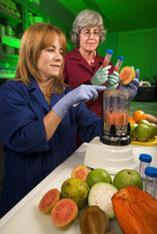
New research into the nutritional content of guava has shown it is higher in antioxidants than previously thought and could join the ranks of superfoods such as blueberries, broccoli and pomegranates. A collaborative effort between US and Thai scientists has found guava’s antioxidant content proved to be around that of orange, grapefruit, and broccoli, and just below that of spinach-all foods that are considered to be high in antioxidants. “For years, there’s been a common notion that you get the best nutritional punch from a few well-publicized foods, such as blueberries, black beans, and broccoli,” said Liz Baldwin, who led the research. Well, they can move over now and make room for a surprising new addition: guava.”
Until recently, only limited information was available about the nutritional composition of tropical fruits-especially the more exotic ones. But in south Florida, growers are not only producing guava, carambola, mango, papaya, and citrus, but also pitahaya, sapodilla, lychee, longan, and mamey sapote. So researchers headed by Baldwin at the US department of agriculture’s Agriculture Research Service (ARS)’s Citrus & Subtropical Products Research Laboratory at Winter Haven, Florida, have been using standard methods to analyse these fruits for components that could be beneficial to human health.
The ARS team worked collaboration with scientists at the University of Florida’s Citrus Research and Education Centre in Lake Alfred. They arere also co-operating with researchers at Siam University in Bangkok and Chiang Mai University, both in Thailand, where some non-Florida native variations of these same fruits are available for testing. At the lab, they are analyzing all these fruits for phytonutrients, flavour, and several other components.
Using a variety of methods to analyse for individual nutrients, the researchers have shown that carambola, red pitahaya, and mamey sapote are all high in antioxidant compounds called phenolics and mamey sapote is also high in fibre. But the one fruit that beats them all is guava. It had the highest antioxidant potential, total phenolics, vitamin C, and dietary fibre.
The findings are likely to help marketers promote these fruit and boost uptake.



